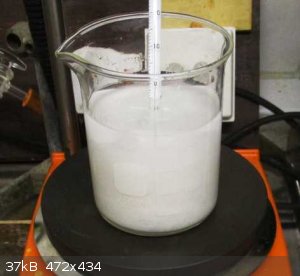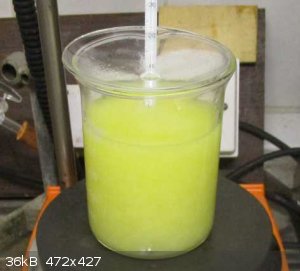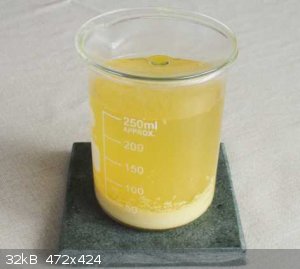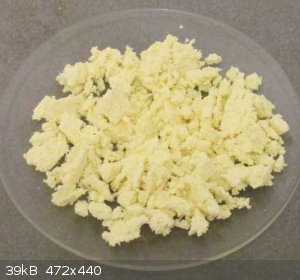| Pages:
1
2
3 |
underground
National Hazard
   
Posts: 703
Registered: 10-10-2013
Location: Europe
Member Is Offline
|
|
ANGN ever made on SM ?
I was wondering for a long time now if anyone on SM ever made 3-amino-1-nitroguanidine nitrate ? It can be made from OTC chems right ? After you got
nitroguanidine, you could use hydrazine sulphate instead of pure hydrazine to form ANG.
ANGN is more powerful than HMX and the chemicals to make are not that hard to find.
[Edited on 9-6-2018 by underground]
|
|
|
DubaiAmateurRocketry
National Hazard
   
Posts: 841
Registered: 10-5-2013
Location: LA, CA, USA
Member Is Offline
Mood: In research
|
|
Yes, ANQN is probably the strongest OTC HEDM.
Note that guanidine in abbreviations is denoted by Q in the current energetic literature, or at least ANQN uses it (Klapotke, 2012). ANQN is the
recognized The route is rather simple, an upscaling would make this thing cheap, it also out-performs RDX in double-base propellants by +5-10 Isp.
The thing about ANQN is that although it has a OB of 0, its CO-OB is actually positive, meaning that it is able to act as an oxygen donor in
propellants. Making it one of the most-promising double-base candidates I have personally encountered.
- Higher Isp and VoD than HMX.
- Cheap
- Cheaper when scaled up
- Slightly oxygen positive
- High density
- Lower Impact sensitivity than RDX
[Edited on 9-6-2018 by DubaiAmateurRocketry]
|
|
|
underground
National Hazard
   
Posts: 703
Registered: 10-10-2013
Location: Europe
Member Is Offline
|
|
Yea it is looks really promising, easy to make and powerful. Some people here have made much more complicated HE like TNGU, TEX, 5-ATZ e.t.c. while no
one ANGN. I believe this compound deserves more respect.
RDX.......................340kbar 8750m/s @ 1.82g/cc
HMX.......................390kbar 9100m/s @ 1.91g/cc
ANGN.....................419kbar 9750m/s @ 1.905g/cc
[Edited on 9-6-2018 by underground]
|
|
|
Microtek
National Hazard
   
Posts: 872
Registered: 23-9-2002
Member Is Offline
Mood: No Mood
|
|
I syntesized a small amount. It is't difficult and the yields are decent, however, it decomposes over time at room temp. It seemed to me that the
decomposition mechanism was loss of nitric acid, which is consistent with the rather low alkalinity of the aminonitroguanidine. Maybe a sealed
container would keep the equilibrium from shifting too far, and thereby keep decomposition to a minimum.
|
|
|
underground
National Hazard
   
Posts: 703
Registered: 10-10-2013
Location: Europe
Member Is Offline
|
|
Quote: Originally posted by Microtek  | | I syntesized a small amount. It is't difficult and the yields are decent, however, it decomposes over time at room temp. It seemed to me that the
decomposition mechanism was loss of nitric acid, which is consistent with the rather low alkalinity of the aminonitroguanidine. Maybe a sealed
container would keep the equilibrium from shifting too far, and thereby keep decomposition to a minimum. |
Hmm what about ANQ perchlorate ? Perchloric acid is generally regarded as the strongest of all known simple acids. It could be much more stable.
Or even aminoguanidne nitrate. It would be wonderful if anyone can tell us the explo5 results for AGN and ANG Perch
Can you tell us pls the method you oblained Hydrazine sulphate and then reacting with NQ ?
[Edited on 10-6-2018 by underground]
|
|
|
DubaiAmateurRocketry
National Hazard
   
Posts: 841
Registered: 10-5-2013
Location: LA, CA, USA
Member Is Offline
Mood: In research
|
|
these can be all found on google scholar, and no, perchlorates ANQ is actually very impact sensitive.
ANQ salts.
https://pdfs.semanticscholar.org/921e/eca88286e0b691bdac1d00...
Aminoguanidine Salts are less studied, because diamino, or the triamino version out performs it.
https://pubs.acs.org/doi/abs/10.1021/ac60059a021?journalCode...
https://patents.google.com/patent/US5726382A/en
[Edited on 10-6-2018 by DubaiAmateurRocketry]
|
|
|
Microtek
National Hazard
   
Posts: 872
Registered: 23-9-2002
Member Is Offline
Mood: No Mood
|
|
The first one of those was the one I based my synthesis on. It is not the first time I have seen a paper that didn't give calculated numbers for
chlorine containing materials. I wonder if the code doesn't handle it well.
I ran the nitrate and the perchlorate through the Kamlet-Jacobs equations, and they seemed to indicate that the nitrate is probably more powerful:
ANQN : D = 9689 m/s P = 431 kbar
ANQP : D = 9178 m/s P = 395 kbar
For the calculation, I assumed that free chlorine would be formed.
|
|
|
underground
National Hazard
   
Posts: 703
Registered: 10-10-2013
Location: Europe
Member Is Offline
|
|
Can you calculate pls for aminoguanidine / diaminoguanidine nitrate ? They would be definitely stable
|
|
|
DubaiAmateurRocketry
National Hazard
   
Posts: 841
Registered: 10-5-2013
Location: LA, CA, USA
Member Is Offline
Mood: In research
|
|
the VoD of ANQN is probably a little lower, EXPLO5 says 9550 if i remember right, regardless, its still of high interest for a rather simple molecule.
underground, aminoguanidine and diaminoguanidine have significantly lower VoDs than ANQN.
|
|
|
Microtek
National Hazard
   
Posts: 872
Registered: 23-9-2002
Member Is Offline
Mood: No Mood
|
|
| Quote: |
the VoD of ANQN is probably a little lower, EXPLO5 says 9550 if i remember right |
Indeed, theoretical predictions are inherently inaccurate. However, the point was to get some kind of figure for the perchlorate salt, since
detonation numbers for it apparently cannot be calculated with EXPLO5. And in order to be able to compare the numbers for the perchlorate salt with
those of the nitrate salt, they should be calculated on the same basis (using the same formulas). Also, I think it is noteworthy that the numbers
based on K-J equations only diverge by 1.5 % from those based on EXPLO5.
| Quote: |
Can you calculate pls for aminoguanidine / diaminoguanidine nitrate ? |
Just google Kamlet-Jacobs equations and plug the numbers into them. You need the heat of formation for the salt as well as for the reaction products
(and you need to make an educated guess as to what the detonation reaction looks like) and also the density.
[Edited on 12-6-2018 by Microtek]
|
|
|
MineMan
International Hazard
    
Posts: 1012
Registered: 29-3-2015
Member Is Offline
Mood: No Mood
|
|
Does anyone have more to share. This seems too good to be true. Gaunidine nitrate can be purchased easily. Then, all one must do is dehydrate with
sulfuric and then add diluted nitric!? And the sensitivity is very low...
This would be the perfect material for small shape charges.. I remember reading that CL-20 can outperform HMX by 40 percent in shape charges. Well,
CL-20 is plagued with problems for us scientist, but ANQN, is safer, cheaper and more powerful. This must be explored.
|
|
|
MineMan
International Hazard
    
Posts: 1012
Registered: 29-3-2015
Member Is Offline
Mood: No Mood
|
|
I was hoping nitrogaunidine could be nitrated to make this molecule... but it looks like hydrazine sulphate is needed? Is there a way to substitute
hydrazine sulphate for hydrazine in synthesis?
|
|
|
Microtek
National Hazard
   
Posts: 872
Registered: 23-9-2002
Member Is Offline
Mood: No Mood
|
|
Well, you need to perform a hydrazinolysis on the nitroguanidine to get to the desired aminonitroguanidine and then form the salt with 65% HNO3 (or
HClo4 or whatever). If you have hydrazine sulfate, you need to freebase it with a strong base, but it may be possible to do it in situ.
|
|
|
kratomiter
Hazard to Others
  
Posts: 106
Registered: 30-9-2012
Member Is Offline
Mood: No Mood
|
|
IIRC, I tried long time ago. The yield was low because precipitation upon adding nitric acid was poor.
|
|
|
Tsjerk
International Hazard
    
Posts: 3032
Registered: 20-4-2005
Location: Netherlands
Member Is Offline
Mood: Mood
|
|
Maybe it can be pushed out of solution with some nitrate salt? Maybe potassium nitrate? Maybe it could even be crystallized with sulfuric acid /
potassium nitrate, which would give you in situ salt to enhance crystallization.
I haven't made any energetics for a decade, but maybe I will try this one...
.
|
|
|
underground
National Hazard
   
Posts: 703
Registered: 10-10-2013
Location: Europe
Member Is Offline
|
|
I think that the nitrate salt is not very stable. Maybe the perchorate salt would be better as long as HCLO4 is stronger than HNO3
[Edited on 5-5-2019 by underground]
|
|
|
MineMan
International Hazard
    
Posts: 1012
Registered: 29-3-2015
Member Is Offline
Mood: No Mood
|
|
Someone needs to try this! For the cause of the forum! And prefect it!! For the forum!
|
|
|
kratomiter
Hazard to Others
  
Posts: 106
Registered: 30-9-2012
Member Is Offline
Mood: No Mood
|
|
I could give it another try, but only with the nitrate salt. I don't have access to perchloric acid.
|
|
|
Laboratory of Liptakov
International Hazard
    
Posts: 1405
Registered: 2-9-2014
Location: Technion Haifa
Member Is Offline
Mood: old jew
|
|
You can do synthesis 3 amino nitroguanidine nitrate ? Thus ANQN? If yes, it will be a great work..... ...LL.....(I am lazy do the aminoguanidine).... ...LL.....(I am lazy do the aminoguanidine)....
[Edited on 6-5-2019 by Laboratory of Liptakov]
Development of primarily - secondary substances CHP (2015) Lithex (2022) Brightelite (2023) Nitrocelite and KC primer (2024)
|
|
|
Microtek
National Hazard
   
Posts: 872
Registered: 23-9-2002
Member Is Offline
Mood: No Mood
|
|
There is no need for using the common ion effect to force more of the product out of solution, since the yield is already more than 90%. The
hydrazinolysis of nitroguanidine is less efficient, giving a yield of about 50%. I think the most interesting experiment would be to examine the
energetic properties of the perchlorate salt relative to the nitrate, since they apparently can't be calculated by Explo5.
|
|
|
Laboratory of Liptakov
International Hazard
    
Posts: 1405
Registered: 2-9-2014
Location: Technion Haifa
Member Is Offline
Mood: old jew
|
|
Quote: Originally posted by Microtek  | | There is no need for using the common ion effect to force more of the product out of solution, since the yield is already more than 90%. The
hydrazinolysis of nitroguanidine is less efficient, giving a yield of about 50%. I think the most interesting experiment would be to examine the
energetic properties of the perchlorate salt relative to the nitrate, since they apparently can't be calculated by Explo5. |
You send me 6g NAQN and you will see Explo6......
Development of primarily - secondary substances CHP (2015) Lithex (2022) Brightelite (2023) Nitrocelite and KC primer (2024)
|
|
|
Microtek
National Hazard
   
Posts: 872
Registered: 23-9-2002
Member Is Offline
Mood: No Mood
|
|
Experimental data are more interesting anyway, especially since scale effects are often quite significant on the ~1 gram scale. When (if) I get around
to making precise comparative tests of the two salts, I will of course report it here.
While we're on the topic of testing small amounts of energetics, I was wondering what would be a good quantitative test for brisance. Sand crush
(detonating a charge in a given amount of coarse sand and measuring how much is crushed into fine sand) is one possibility, however it requires that
all the sand is contained. Metal indentation (in a lead or copper block) is another, but I worry that the indentations will not be very different and
that random variation would mean I had to reproduce the test many times. I also considered spalling; then you could simply weigh a steel witness plate
before and after to find out how much had been removed from the opposite side. The question is how consistent results such a test would give...
If anyone has any insights, suggestions or inspiration to offer, I would welcome it.
|
|
|
MineMan
International Hazard
    
Posts: 1012
Registered: 29-3-2015
Member Is Offline
Mood: No Mood
|
|
Microtek. Sand crushing, or lead block. Best yet is shape charge penetration!
|
|
|
Laboratory of Liptakov
International Hazard
    
Posts: 1405
Registered: 2-9-2014
Location: Technion Haifa
Member Is Offline
Mood: old jew
|
|
comparating testing
Lead block is pretty good compromise for comparative testing.

However during measurement, in same block, is necessary always create reference impact from known EM. As reference is here CHP.... ...LL ...LL
Development of primarily - secondary substances CHP (2015) Lithex (2022) Brightelite (2023) Nitrocelite and KC primer (2024)
|
|
|
Boffis
International Hazard
    
Posts: 1879
Registered: 1-5-2011
Member Is Offline
Mood: No Mood
|
|
OK. The synthesis of this compound and its nitrate salt have been discussed to death on Science Madness but once again much talk, a few claims to have
prepared it but no details or photographs. The aim of this post is to remedy that omission. I have not prepared the nitrate salt as I have no
particular interest in it but I have significant interest in the free base.
Experimental
Heat 200ml of water to 55°C in the 250ml beaker, add 16g of nitroguanidine and stir the suspension until the temperature returns to 55 C.
Add 8.4ml of 98% hydrazine hydrate dropwise over a period of about 5 minutes or so and then the temperature was maintained within the range 55-56 C
for a total of 17-20 minutes from the commencement of the hydrazine addition or until all of the solid has dissolved. The reaction mixture turn
progressively deeper yellow as the reaction takes place.
The reaction mixture was then cooled rapidly in a cold-water bath and once the temperature had fallen below about 45°C the mixture of quenched by
neutralizing to about pH 7, roughly 10 ml of 30% HCl were required. The pale yellow reaction mixture was then chilled for several hours in the fridge
to below 5°C. The pale yellow granular solid was filtered off, washed with a little cold water and dried. The yield of crude material was 9.367g.
The crude product was recrystallized from 100ml of nearly boiling water (I have found that roughly 11ml/g with the water at 90+°C before adding the
nitroaminoguanidine seems to be the optimum). As soon as the solid had dissolved the beaker was placed into a cold water bath until the temperature
was <35°C and then placed in the fridge for several hours. The pale cream solid was filter off, washed with a little water and dried to yield
8.56g (45%).
This preparation has been carried out numerous times and most give 45-48% yield after recrystallization but occasionally up to 50%.
 Nitroguanidine suspension at 55 C Nitroguanidine suspension at 55 C
 Hydrazine hydrate and 8.4ml measured out Hydrazine hydrate and 8.4ml measured out
 Complete addition of the hydrazine and the solution starting to turn yellow T= 5 minutes Complete addition of the hydrazine and the solution starting to turn yellow T= 5 minutes
 Almost complete solution of the nitroguanidine T= 17 minutes, yellow colour at its most intense Almost complete solution of the nitroguanidine T= 17 minutes, yellow colour at its most intense
 The product crystallizing out from the chilled solution The product crystallizing out from the chilled solution
 The final re-crystallised product. Still slightly cream, a second re-crystallization gives a practically white product The final re-crystallised product. Still slightly cream, a second re-crystallization gives a practically white product
I will prepare a more complete write up for the Prepublication section in due course.
[Edited on 23-5-2019 by Boffis]
|
|
|
| Pages:
1
2
3 |